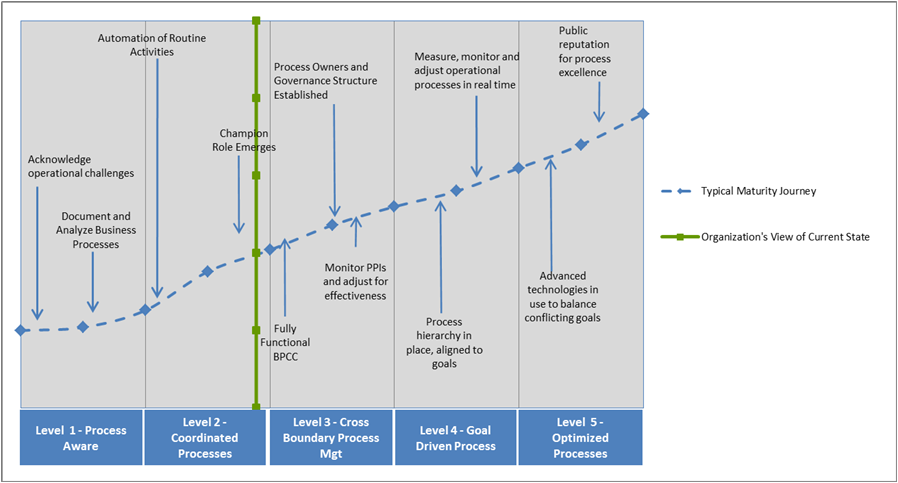
Over the past year, our Business Process Excellence practice has been working to develop an Enterprise Business Process Management (BPM) Framework for our organization, with implementation beginning this year. We utilize Lean, Six Sigma, Workout, Kaizen and facilitation methods to improve business processes that drive measurable business outcomes. BCBSNC is an $8 Billion dollar business with over 4500 employees and have had an established Business Process practice since 2008. We have a very strong brand and have driven over $80+ million in results since inception.
To initiate the next evolution of our business process practice, we culturally assessed the maturity and enterprise adoption of the tools and capabilities to solve business problems. In early 2015, we brought in an external partner to help us look at our current maturity, industry best practices and help us design an iterative solution. They also conducted a methodology gap assessment, measuring our maturity, and identified targeted initiatives to increase our maturity to a level 2 initially.

We began with the end in mind and developed a multiyear road map with measurable outcomes.

We then added it to our annual goals, worked to gain leadership commitment and created an executive steering committee that would help us with the rollout and change adoption. We wrote our case for change, completed a stakeholder management assessment, presented to our senior leadership and got a green light to go forward. We were excited by finally making it to this point. Taking this big step forward has been our vision for many years, waiting for the right time to roll out. We attempted this in the past, without success, so we did have some strong apprehensions.
When we defined Business Process Management, we believed the hardest problem to solve was clear and accepted value stream management owners as we would be asking them to have accountability for process aspects they did not directly manage. Gaining agreement to own something that does not report into you, is extremely difficult, but necessary in a highly matrixed organization. But working with our stakeholders, senior management and our steering committee we began to make solid progress.
By now, the reader is probably thinking “sounds like you did everything right, so what is the story here?” In all our outward focus, we made a fundamental mis-calculation in our approach to this next practice evolutionary step. We did not start with fully understanding the impact for the internal team. We would be shifting the very foundation of their work, to include: skills, tools and accountabilities.
When we prepared the case for change, it was focused on the great things it would do for the enterprise. We did not recognize or see this change to be a significant one for our staff regarding the way they work and interact. For them, this new methodology was risky; it was challenging the “status quo”. We also missed that this would change the way we, as a business process team, were organizationally structured and how we approached our work. We uncovered gaps in our tools and skill sets for designing and improving processes, and providing consultative support to the enterprise in a new and more meaningful way.
The team rolling out the new BPM Framework couldn’t understand why the BPE team wasn’t more excited. They are change agents after all and really should be “getting this” before the enterprise. The situation we found ourselves in was the enterprise leadership was more excited than our staff. Having this disconnect impacted the team, the camaraderie and provided setbacks to the progress.
We literally had to take a step back and work in parallel to ensure our business process consultants understood the value, what was in it for them (WIIFM) and make an internal case for change. We had informal and formal discussions, identified where roles needed to change and introduced a new role focused on supporting the Value Stream business owners.
In the end, we have found that the team has a much tighter relationship with our business leaders; we are working on identifying more strategic initiatives and beginning to see a clearer path to driving value. In order to do this, we had to recognize that our team members have to see the clear alignment to the work, how they can positively impact change and deliver solid results.
We are just ramping into one main Value Stream around our Member Acquisition process. We have a value stream owner, an assigned Business Process consultant lead and other business process consultants that are helping to map out the value stream, identify the metrics and pull together the prioritization process. This will be a great case study as to how we can shift the organization with these new tools and also to better understand the process areas that need redesigning vs. automating. The latter is where a strong partnership with your Information Technology group comes into play. They can help you identify the right business process automation tools and also benefit from the work the Business Process teams do.
In order for Business Process Management to be successful, it is critical that your business process consultant team understand why this is needed. How they will engage and how they will be supported as they learn new skills. It is a dual journey, one of evolving your team and the other of evolving the business process owners and enterprise leaders. Without the right engagement and support from both entities, you cannot be successful.
There are no products in your shopping cart.
| 0 Items |